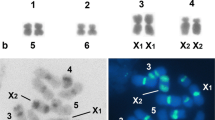Abstract
The satellite DNA (satellite III) which is mainly represented in the female of Elaphe radiata (Ophidia, Colubridae) has been isolated and its buoyant density has been determined (ϱ=1.700 g cm−3). In situ hybridisation of radioactive complementary RNA of this satellite DNA with the chromosomes of different species has revealed that it is mainly concentrated on the W sex chromosome and its sequences are conserved throughout the sub-order Ophidia. From hybridisation studies these sequences are absent from the primitive family Boidae which represents a primitive state of differentiation of sex chromosomes. Chromosome analysis and C-banding have also revealed the absence of heteromorphism and of an entirely heterochromatic chromosome in the species belonging to the primitive family and their presence in the species of highly evolved families. It is suggested that the origin of satellite DNA (satellite III) in the W chromosome is the first step in differentiation of W from the Z in snakes by generating asynchrony in the DNA replication pattern of Z and W chromosomes and thus conceivably reducing the frequency of crossing-over between them which is the prerequisite of differentiation of sex chromosomes. Presence of similar sex chromosome associated satellite DNA in domestic chicken suggests its existence in a wider range of vertebrates than just the snakes.
Similar content being viewed by others
References
Birnstiel, M.L., Sells, B.H., Purdom, I.F.: Kinetic complexity of RNA molecules. J. molec. Biol. 63, 21–39 (1972)
Birnstiel, M.L., Spiers, J., Purdom, I.F., Jones, K., Loening, U.E.: Properties and composition of the isolated ribosomal DNA satellite of Xenopus laevis. Nature (Lond.) 219, 454–463 (1968)
Bishop, J.O.: The effect of genetic complexity on the time-course of ribonucleic acid hybridisation. Biochem. J. 113, 805–811 (1969)
Britten, R.J., Kohne, D.E.: Repeated sequences in DNA. Science 161, 529–540 (1968)
Brown, D.D., Wensink, P.C., Jordan, E.: A comparison of the ribosomal DNA's of Xenopus laevis and Xenopus mulleri: the evolution of tandem genes. J. molec. Biol. 63, 57–73 (1972)
Comings, D.E.: The structure and function of chromatin. Advanc. hum. Genet. 3, 237–431 (1972)
Gillespie, D., Spiegelman, S.: A quantitative assay for DNA-RNA hybrids with DNA immobilised on a membrane. J. molec. Biol. 12, 829–842 (1965)
Jensen, R.H., Davidson, N.: Spectrophotometric, potentiometric and density gradient ultracentrifugation studies of the binding of silver ion by DNA. Biopolymers 4, 17–32 (1966)
Jones, K.W.: In situ hybridisation. In: New techniques in biophysics and cell biology (R.H. Pain and B.J. Smith, eds.), Vol. 1, p. 29–66. London: J. Wiley and Sons 1973
Jones, K.W., Purdom, I.F., Prosser, J., Corneo, G.: The chromosomal location of human satellite I DNA. Chromosoma (Berl.) 49, 161–171 (1974)
Kunkel, L.M., Smith, K.D., Boyer, S.H.: Human Y-chromosome-specific reiterated DNA. Science 191, 1189–1190 (1976)
Kurnit, D.M., Shafit, B.R., Maio, J.J.: Multiple satellite deoxyribonucleic acids in the calf and their relation to the sex chromosomes. J. molec. Biol. 81, 273–284 (1973)
Marmur, J.: A procedure for the isolation of deoxyribonucleic acid from microorganisms. J. molec. Biol. 3, 208–218 (1961)
Moar, M.H., Purdom, I.F., Jones, K.W.: Influence of temperature on the detectibility and chromosomal distribution of specific DNA sequences by in situ hybridisation. Chromosoma (Berl.) 53, 345–359 (1975)
Natarajan, A.T., Gropp, A.: The meiotic behaviour of autosomal heterochromatic segments in hedgehogs. Chromosoma (Berl.) 35, 143–152 (1971)
Ohno, S.: Sex chromosomes and sex-linked genes. Berlin-Heidelberg-New York: Springer 1967
Ray-Chaudhuri, S.P., Singh, L.: DNA replication pattern in sex-chromosomes of snakes. Nucleus (Calcutta) 15, 200–210 (1972)
Ray-Chaudhuri, S.P., Singh, L., Sharma, T.: Sexual dimorphism in somatic interphase nuclei of snakes. Cytogenetics 91, 410–423 (1970)
Ray-Chaudhuri, S.P., Singh, L., Sharma, T.: Evolution of sex chromosomes and formation of W chromatin in snakes. Chromosoma (Berl.) 33, 239–251 (1971)
Singh, L.: Evolution of karyotypes in snakes. Chromosoma (Berl.) 38, 185–236 (1972)
Singh, L.: Chromosomes of six species of Indian snakes. Herpetologica 30, 419–429 (1974)
Singh, L., Ray-Chaudhuri, S.P.: Localization of C-band in the W sex chromosome of the common Indian Krait Bungarus caeruleus Schneider. Nucleus (Calcutta) 18, 163–166 (1975)
Singh, L., Sharma, T., Ray-Chaudhuri, S.P.: W chromosome in the Indian water snake (checkered keel back) Natrix piscator (Colubridae). Experientia (Basel) 24, 79–80 (1968)
Singh, L., Sharma, T., Ray-Chaudhuri, S.P.: Multiple sex-chromosomes in the common Indian Krait, Bungarus caeruleus Schneider. Chromosoma (Berl.) 31, 386–391 (1970)
Sumner, A.T.: A simple technique for demonstrating centromeric heterochromatin. Exp. Cell Res. 75, 304–306 (1972)
Stefos, K., Arrighi, F.E.: Repetitive DNA of Gallus domesticus and its cytological locations. Exp. Cell Res. 83, 9–14 (1974)
Thomas, J.B., Kaltsikes, P.J.: A possible effect of heterochromatin on chromosome pairing. (Giemsa banding/triticale/amphiploid/synthetic species). Proc. nat. Acad. Sci. (Wash.) 71, 2787–2790 (1974)
Author information
Authors and Affiliations
Rights and permissions
About this article
Cite this article
Singh, L., Purdom, I.F. & Jones, K.W. Satellite DNA and evolution of sex chromosomes. Chromosoma 59, 43–62 (1976). https://doi.org/10.1007/BF00327708
Received:
Issue Date:
DOI: https://doi.org/10.1007/BF00327708




